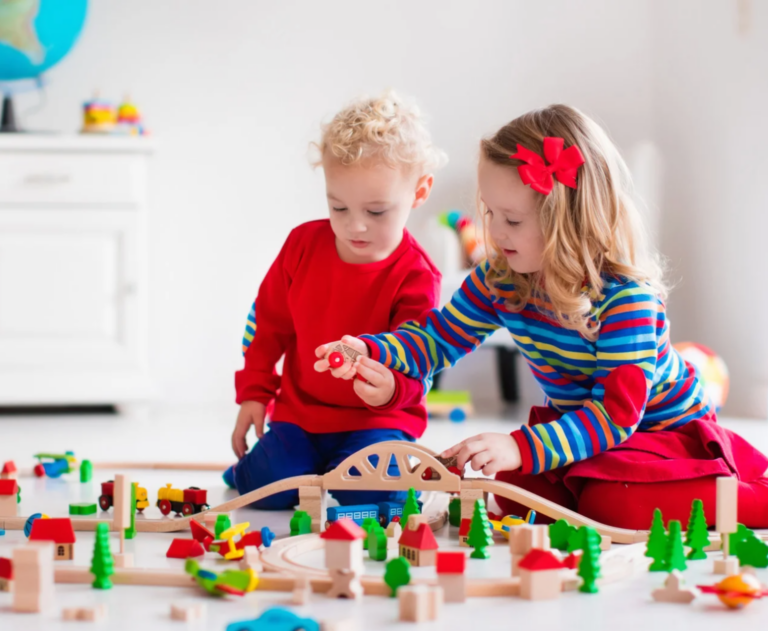Have you ever watched children at play and noticed how differently they engage with the world around them? Some might be lost in imaginative storytelling, others focused on creating colourful artwork, while some are bursting with energy, running and laughing with peers. Play isn’t just about having fun, it’s how children learn, explore, and develop essential skills.
Every child learns in their own way, some absorb information visually, others through sound, and many by doing. Recognising these differences helps create enriching learning experiences tailored to their needs. One of the most effective ways to support this development is through sensory play, which engages touch, sight, sound, smell, and movement to build cognitive, language, and motor skills.
For most children, sensory processing happens naturally, enabling them to navigate their environment with ease. While some face sensory challenges that can make everyday experiences overwhelming. According to research from the Australian Institute of Health and Welfare (AIHW), approximately 1 in 20 children experience sensory processing difficulties, which can be associated with conditions such as Autism Spectrum Disorder (ASD), Attention Deficit Hyperactivity Disorder (ADHD), and Sensory Processing Disorder (SPD). These challenges can affect how a child reacts to touch, sound, movement, and visual stimuli.
Sensory play has a crucial role in supporting children with sensory difficulties by engaging their senses like touch, taste, smell, sight, hearing, body awareness, and balance. Research from the Raising Children Network highlights that sensory-rich experiences promote brain development from infancy, helping children explore and interact with their environment as their sensory system matures.
Benefits of Sensory Play
Sensory learning has a host of benefits that affect the ongoing development and wellbeing of children. Research from the Australian Institute of Health and Welfare (AIHW) indicates that early childhood experiences significantly influence neural connections, shaping a child’s ability to learn, focus, and regulate emotions.
Here are some of the key benefits of sensory play and how it positively impacts a child’s growth.
1. Fosters Brain Development
Early brain development lays the foundation for a child’s ability to learn, adapt, and interact with the world. Sensory play stimulates the five primary senses -touch, taste, smell, sight, and hearing, helping to strengthen neural pathways that support cognitive growth.
According to the Australian Early Development Census (AEDC), early childhood experiences play a crucial role in shaping brain architecture, with over one million new neural connections forming every second in the first few years of life.
These connections, known as synapses, are essential for learning, memory, and problem-solving. For example, when a child touches an object, their brain processes the sensation in identifying whether it is rough, smooth, hot, or cold, before sending signals through the nervous system to help them react accordingly. Repetitive sensory experiences reinforce these pathways, improving a child’s ability to process information and develop critical thinking skills.
2. Supports Cognitive Development
Cognitive development is the process through which children learn to think critically and make sense of the world. Sensory play supports this growth by engaging curiosity, fostering problem-solving, creativity, and independent thinking.
Activities like finger painting help children explore textures and colours, teaching cause and effect and basic scientific principles. Playing musical instruments strengthens pattern recognition, auditory processing, and hand-eye coordination, supporting language and math skills.
Incorporating sensory activities into daily routines helps children develop vital cognitive skills for lifelong learning.
3. Enhances Language Development
Sensory play is a powerful tool for language development, engaging multiple senses and expanding vocabulary. Through hands-on activities, children encounter new words linked to their experiences.
Parents, educators, and carers can enhance this learning by intentionally introducing new vocabulary words in real time. For example, while children engage with a sensory bin filled with various objects such as sand, rice, shells, or small toys, adults can name each item, describe its characteristics (e.g., smooth, rough, soft, hard), and encourage repetition. This interactive approach helps reinforce word recognition, strengthens language comprehension, and builds a richer vocabulary.
Sensory play also encourages conversation, as children ask questions and describe their experiences. Open-ended questions like “How does this feel?” promote meaningful dialogue and language growth.
4. Encourages Motor Skills Development
Sensory play helps children in developing essential motor skills, which are critical for their overall physical growth, coordination, and daily activities.
Motor skills are divided into two categories: fine motor skills and gross motor skills, both of which can be effectively strengthened through engaging sensory experiences.
- Fine motor skills: Involves the use of small muscle groups, particularly in the hands and fingers, which are essential for tasks such as holding a pencil, buttoning a shirt, and tying shoelaces. Sensory activities like moulding playdough, threading beads, or finger-painting help refine these skills by encouraging precise hand movements, grip control, and finger dexterity.
- Gross motor skill: Involves larger muscle groups that support whole-body movements such as walking, running, and jumping. Sensory play activities like jumping on a trampoline, balancing on stepping stones, or engaging in water play encourage children to build core strength, coordination, and overall physical endurance.
5. Fosters Social-Emotional Development
Social-emotional development helps children in regulating their emotions, building resilience, and forming positive relationships with both peers and adults. Activities like water play or making music have a soothing effect, helping children manage their emotions and calm down when feeling overwhelmed.
Group activities such as throwing a ball, playing tag, or following the leader help children practice cooperation, turn-taking, and communication. These activities require children to interact with others, follow rules, and engage in team-based problem-solving.
By participating in these types of sensory play, children develop empathy, learn to understand different perspectives, and enhance their ability to collaborate effectively.
Types of Sensory Play
1. Tactile Play
Tactile play is one of the most common forms of sensory play, involving exploration through touch. When children use their hands to interact with different objects, they engage in tactile play, which helps them understand various sensory experiences such as texture, temperature, pressure, and vibrations.
This type of play is essential for their development, as it allows them to explore the world through their sense of touch, building both their fine motor skills and sensory awareness.
Here are some engaging tactile play activities you can try:
- Cornstarch Dough: A soft, mouldable dough that provides a unique texture, great for shaping and squeezing
- Homemade Flubber: A stretchy, bouncy material that offers an exciting, tactile experience for kids to explore.
- Slime: Soft, light, and fun to squish, slime encourages hands-on play while enhancing sensory exploration.
- Foam Dough: A cloud-like dough that is fun to manipulate, offering a soft and airy texture for children to explore.
- Sensory Sand: Easily mouldable into castles and shapes, it instantly returns to sand for repeated use. This sensory activity enhances hand-eye coordination and fine motor skills, making it ideal for both classrooms and homes.
- Play Dough: A classic sensory activity that allows children to roll, squish, and shape the play dough into different creations, developing their hand-eye coordination and tactile perception.

2. Vestibular Sensory Play
Vestibular sensory play involves activities that help children develop their sense of balance and spatial awareness. This sense is controlled by the vestibular system, located in the inner ear, which is responsible for detecting motion and maintaining balance.
Engaging in physical activities that involve rolling, swinging, jumping, or hanging upside down stimulates the vestibular system, strengthening the brain’s ability to process balance-related information.
According to the Australian Institute of Health and Welfare (AIHW), physical play is essential for developing gross motor skills and overall physical health, which is why activities that engage the vestibular system, like swinging or climbing, are vital for children’s growth.
Some fun vestibular activities for children involve:
- Rolling Around: Encourages balance and body awareness by shifting weight in different directions.
- Swinging: Stimulates the vestibular system, improving coordination and strengthening the ability to focus.
- Jumping: Enhances both balance and muscle control, helping to develop gross motor skills.
- Hanging Upside Down: Activates the vestibular system, improving spatial awareness and coordination.
3. Proprioception Sensory Play
For children, developing proprioception is a crucial step in mastering physical coordination and spatial awareness. It’s what helps them navigate the world confidently, from learning to balance on one foot to performing complex movements like running or jumping.
Proprioception sensory play gives children the opportunity to enhance this skill by engaging in activities that provide feedback to their muscles and joints.
Here are some of the examples:
- Pushing or pulling heavy objects: Activities like moving a wagon or a large ball engage muscles and build strength while boosting body awareness. Children gain a better sense of how their movements feel and how their body interacts with the space around them.
- Jumping on a trampoline: This activity not only improves balance and coordination but also provides valuable sensory feedback, allowing children to better understand the force, direction, and rhythm of their movements, helping them build control and confidence.
- Carrying weighted objects: Whether it’s a backpack or a weighted blanket, carrying these objects helps strengthen posture and body alignment. It encourages children to engage their muscles and regulate their movements, fostering improved balance and physical awareness.
4. Auditory Sensory Play
Bang, boom, clash! While it might not be music to your ears, auditory sensory play offers incredible benefits for your child’s development. By engaging with different sounds, children learns to distinguish between varying pitches, volumes, and rhythms, fostering their auditory processing skills.
One simple way to introduce auditory play is by handing your child a wooden spoon and a saucepan. As they tap, bang, and explore, they’ll discover how sound changes depending on the material and force used.
While it can be a bit noisy for parents, this form of sensory play supports cognitive and language development by stimulating the brain’s auditory centres.
So, even if the loud clattering drives you a bit crazy, remember that it’s all part of your child’s learning experience.
5. Visual Sensory Play
The visual sensory play helps children sharpen their vision while strengthening their ability to focus, track movement, and process visual information.
A simple example is when you move a spoon, pretending it’s an “aeroplane,” guiding it toward their mouth. This action helps your child develop eye coordination and focus as they track the spoon’s movement with their eyes.
Engaging your child in activities that involve exploring colours, shapes, and patterns can be both fun and beneficial. For instance, playing with colourful blocks, shape sorters, or puzzles encourages a child to identify and match different hues and forms. Visual sensory play also includes activities like observing changing light patterns, watching moving objects, or even playing games that involve sorting or stacking based on colour and shape.
6. Olfactory and Taste Sensory Play
The olfactory system, responsible for our sense of smell, is closely linked with the taste system, both playing vital roles in how children interact with their environment. Though it’s often hard to pinpoint when a child uses these senses, clear examples include inhaling the scent of flowers or tasting new objects, like building blocks.
Olfactory and taste sensory play helps nurture these senses through activities like smelling different fruits, herbs, or flowers, and identifying their scents. You can also create a “scent station” with spices, fruits, or scented oils for children to explore.
Taste-testing games, where kids sample sweet, sour, salty, and bitter flavours, help them develop taste recognition. Comparing textures and flavours of different foods also enhances their ability to distinguish tastes.
These sensory activities foster curiosity, concentration, and self-regulation while building a strong foundation for sensory exploration through scent and flavour.
Supporting Sensory Needs in Schools
Australian schools are increasingly recognising the importance of creating sensory-friendly environments to support students with sensory processing challenges.
Research from the Australian Education Research Organisation (AERO) has highlighted the significant benefits of classrooms designed with flexibility in mind. Incorporating elements such as adjustable seating, quiet zones, and scheduled movement breaks has been shown to improve focus, participation, and overall wellbeing for children with sensory needs.
In these inclusive classrooms, teachers can use a range of strategies to help students manage sensory overload and maintain engagement throughout the school day. Here are several key approaches:
Alternative seating options: By providing flexible seating choices, such as wobble stools, standing desks, or even floor seating, students can choose the most comfortable way to engage with their learning. These options cater to individual needs and allow students to move as they work, which can help regulate their sensory experiences and promote better focus.
Brain breaks: Incorporating regular movement breaks, such as stretching exercises, yoga, or quick physical activities, allows students to release built-up energy and refocus. These breaks are particularly important for children who may struggle to sit still for extended periods. Movement exercises can also improve blood flow and help students reset mentally, enhancing their participation in lessons.
Visual schedules: Transitioning between activities can be challenging for children with sensory processing difficulties. Visual schedules offer clear, predictable information about what comes next, making transitions smoother and reducing anxiety. By providing visual cues such as pictures or symbols, teachers help students understand and anticipate changes in the daily routine, promoting a sense of security and autonomy.
Sensory support is crucial for children with sensory processing challenges, helping them better navigate their environment, enhance their learning, and improve emotional regulation.
Australian research from organisations like the Australian Institute of Health and Welfare (AIHW), the Australian Centre for Research in Children’s Health (ACRC), Occupational Therapy Australia (OTA), and the Murdoch Children’s Research Institute (MCRI) highlights the importance of individualised interventions, supportive environments, and structured sensory activities.
With 1 in 20 Australian children affected, sensory difficulties can impact schoolwork, social interactions, and daily life. Implementing sensory-friendly strategies at home, in schools, and through therapy will help children thrive, building confidence, resilience, and independence for long-term success.

